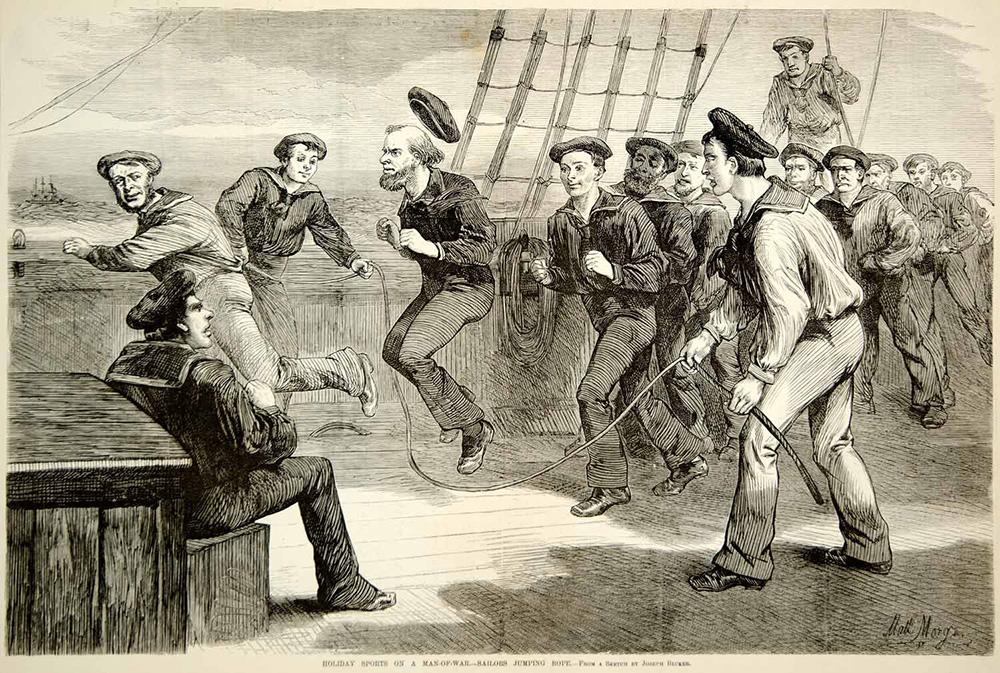Ever wondered where the fun-filled activity of jump roping originated from?
Believe it or not, the history traces back to over 4000 years ago in ancient cultures.
Bạn đang xem: Who Invented The Jump Rope Updated 07/2024
In this article, we’ll take an enthralling journey through time, exploring the intriguing origins and evolution of jump rope.
Ready for this exciting trip down memory lane? Let’s dive in!

The Origins of Jump Rope
Chinese rope makers and the Hundred Rope Jumping game
The Hundred Rope Jumping game is a fascinating aspect of the story behind the origins of jump rope. This intriguing game, which was part of New Year’s festivities in ancient China, involved ropemakers jumping over their own creations.
Referred to as “Jumping 100 Threads,” it symbolized good fortune and prosperity for the coming year.
The International Rope Skipping Federation confirms this Chinese origin story of jump rope, highlighting how these ropemakers’ ceremonies laid the groundwork for today’s sport.
European boys and skipping in the 17th century
In the 17th century, European boys discovered the joy of skipping rope. During this time, skipping became a popular pastime for young children across Europe.
They would gather in open fields or streets and start swinging their ropes, jumping over them with enthusiasm and laughter.
Skipping was not only seen as a fun activity, but also as a way to develop coordination and agility. It quickly spread throughout different countries in Europe, becoming a beloved game that entertained generations of children.
The simplicity of using just a rope made it accessible to all, regardless of social status or background.
Little did these European boys know that they were unknowingly contributing to the rich history and evolution of jump rope as we know it today.
Dutch settlers bring jump rope to America
Dutch settlers played a crucial role in bringing jump rope to America. In the early 17th century, the Dutch colonists arrived in New Amsterdam (now known as New York City) and brought with them their love for skipping rope.
Xem thêm : Can You Jump Rope While Pregnant Updated 07/2024
They introduced the activity to American children, who quickly embraced it as a fun and entertaining pastime.
With its simple yet challenging nature, jump rope soon became popular among both boys and girls across the country.
The Dutch settlers’ influence on American culture extended beyond just introducing the activity itself; they also contributed to various jump rope variations that emerged over time, such as Double Dutch.
The Invention of Double Dutch
The role of ropemakers in developing the style
Ropemakers played a significant role in developing the style of jump rope we know today. In ancient China, these skilled craftsmen created strong and durable ropes for various purposes, including for use in the Hundred Rope Jumping game.
This game involved multiple people jumping over a long rope while chanting rhymes or singing songs. Over time, ropemakers began experimenting with different techniques and materials to enhance the performance of the ropes, making them more flexible and easier to handle during jumps.
Their innovations eventually led to the development of double Dutch, a popular style of jump rope that involves two ropes being turned in opposite directions as participants jump in sync.
Today, ropemakers continue to contribute to the evolution of jump rope by creating specialized ropes with varying thicknesses and weights to cater to different skill levels and training purposes.
Evolution of Double Dutch as a popular jump rope variation
Double Dutch is a popular jump rope variation that has evolved over the years. It originated in the streets of New York City in the 1970s and quickly gained popularity among urban youth.
The style involves two ropes being turned in opposite directions while one or more jumpers try to time their jumps between them.
What started as a fun activity for young girls has now become an international sport with competitions and championships.
Ropemakers played a crucial role in developing Double Dutch, experimenting with different techniques and styles to make it more exciting.
Today, there are even official rules and regulations governing Double Dutch competitions.
Fun Facts about Jump Rope
Jump rope activity traced back to ancient Egypt
Jump rope activity can be traced back to ancient Egypt, where they used vines for jumping. This form of exercise and play has been around since 1600 A.D., showcasing the long-standing tradition of skipping rope throughout history.
It’s fascinating to see how something as simple as a piece of rope can provide so much enjoyment and physical activity for people across different cultures and time periods.
Whether it’s for fitness or just pure fun, jumping rope has stood the test of time and continues to be a popular activity today.
Jump rope becoming popular in various cultures
Xem thêm : Best Machine In Gym To Lose Belly Fat Updated 07/2024
Jump rope has become a popular activity in various cultures around the world. From ancient Egypt to modern-day America, people have embraced this fun and energetic exercise.
In fact, jump rope can be traced back to as early as 1600 B.C., when the Chinese rope makers invented the Hundred Rope Jumping game as part of their New Year’s celebrations.
Over time, different countries and communities have put their own spin on jump rope, creating unique variations like Double Dutch.
Today, jump rope is not only seen as a recreational activity but also as a competitive sport with organizations such as the International Rope Skipping Federation promoting its practice worldwide.
Whether for cardiovascular health or simply having a good time, it’s no wonder that jump rope has gained popularity across cultures.
Benefits of jumping rope for cardiovascular health
Jumping rope is not just a fun and nostalgic activity, but it also offers numerous benefits for cardiovascular health.
When you jump rope, your heart rate increases, promoting better blood circulation throughout the body.
This helps strengthen your heart over time, making it more efficient at pumping blood to deliver oxygen and nutrients to your muscles and organs.
In fact, studies have shown that jumping rope can provide a similar cardiovascular workout as running or jogging. It helps improve your endurance, stamina, and overall cardiovascular fitness.
Regular jump rope sessions can help lower your resting heart rate and reduce the risk of developing cardiovascular diseases such as high blood pressure and heart disease.
Not only does jumping rope get your heart pumping, but it also engages major muscle groups in your legs (calves, quads), core (abdominals), and arms (shoulders).
This full-body workout burns calories effectively which can contribute to weight loss when combined with a balanced diet.
Conclusion
In conclusion, the invention of the jump rope cannot be attributed to a single individual or a specific moment in history. Instead, it evolved over time, with various cultures contributing to its development.
From Chinese rope makers and European boys skipping to Dutch settlers bringing it to America, the origins of jump rope are rich and diverse.
What matters most is that this simple yet effective exercise tool has endured throughout history and continues to be enjoyed by people around the world for its cardiovascular benefits and sheer fun factor.
Nguồn: https://usgyms.net
Danh mục: Gym Equipment










